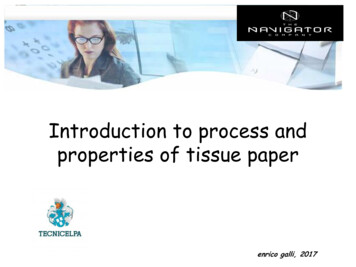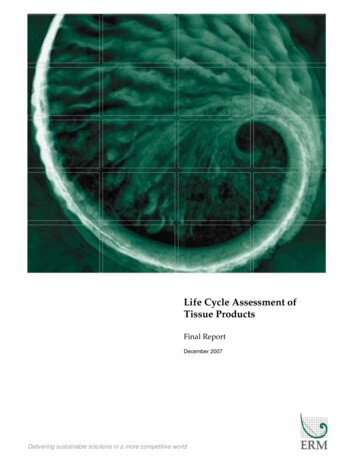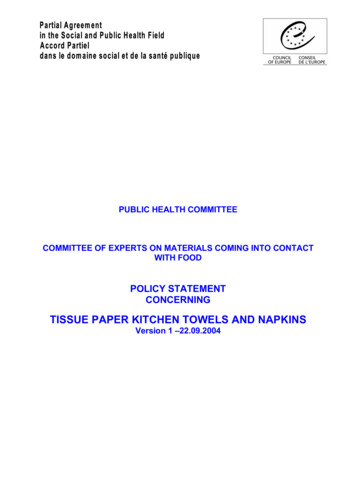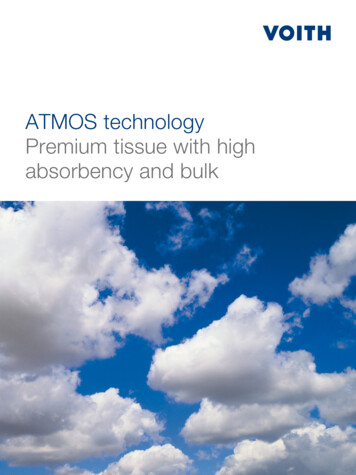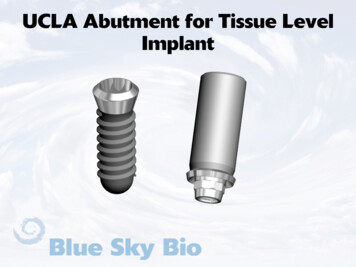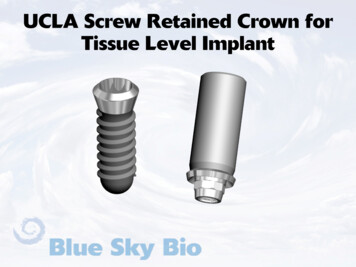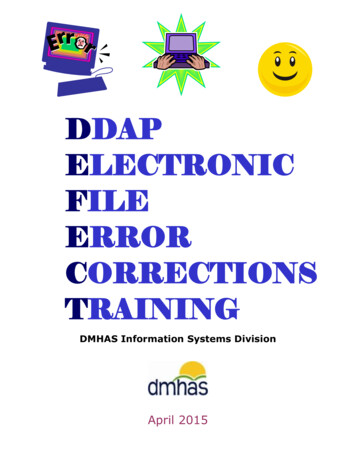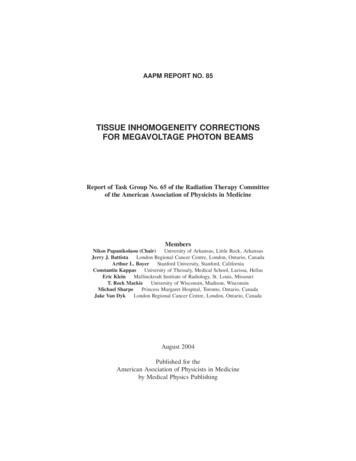
Transcription
AAPM REPORT NO. 85TISSUE INHOMOGENEITY CORRECTIONSFOR MEGAVOLTAGE PHOTON BEAMSReport of Task Group No. 65 of the Radiation Therapy Committeeof the American Association of Physicists in MedicineMembersNikos Papanikolaou (Chair)University of Arkansas, Little Rock, ArkansasJerry J. BattistaLondon Regional Cancer Centre, London, Ontario, CanadaArthur L. BoyerStanford University, Stanford, CaliforniaConstantin KappasUniversity of Thessaly, Medical School, Larissa, HellasEric KleinMallinckrodt Institute of Radiology, St. Louis, MissouriT. Rock MackieUniversity of Wisconsin, Madison, WisconsinMichael SharpePrincess Margaret Hospital, Toronto, Ontario, CanadaJake Van DykLondon Regional Cancer Centre, London, Ontario, CanadaAugust 2004Published for theAmerican Asociation of Physicists in Medicineby Medical Physics Publishing
DISCLAIMER: This publication is based on sources and information believedto be reliable, but the AAPM, the editors, and the publisher disclaim any warranty or liability based on or relating to the contents of this publication.The AAPM does not endorse any products, manufacturers, or suppliers.Nothing in this publication should be interpreted as implying such endorsement.Further copies of this report ( 15 prepaid) may be obtained from:Medical Physics Publishing4513 Vernon Blvd.Madison, WI 53705-4964Telephone: 1-800-442-5778 or608-262-4021Fax: 608-265-2121Email: mpp@medicalphysics.orgWeb site: www.medicalphysics.orgInternational Standard Book Number: 1-888340-47-9International Standard Serial Number: 0271-7344 2004 by American Association of Physicists in MedicineOne Physics EllipseCollege Park, MD 20740-3846All rights reserved. No part of this publication may be reproduced, stored in aretrieval system, or transmitted in any form or by any means (electronic,mechanical, photocopying, recording, or otherwise) without the prior writtenpermission of the publisher.Published by Medical Physics Publishing4513 Vernon Boulevard, Madison, WI 53705-4964Printed in the United States of America
TABLE OF CONTENTSAbstract .vI.INTRODUCTION.1II.NEED FOR INHOMOGENEITY CORRECTIONS.3A. Required Dose Accuracy .31. Slopes of dose-effect curves.42. The level of dose differences that can be detected clinically .43. The level of accuracy needed for clinical studies .54. The level of dose accuracy that will be practicallyachievable .8B. Recommended Accuracy in Tissue Inhomogeneity Corrections .9III.RADIATION PHYSICS RELEVANT TO PHOTONINHOMOGENEITY CALCULATIONS .10A. Photon Interactions: The TERMA Step .10B. Charged Particle Interactions: The DOSE Step .11C. Charged Particle Equilibrium.141. Longitudinal TCPE.152. Lateral TCPE .16D. Influence of Tissue Density and Atomic Number .161. Density scaling .162. Effects of atomic number.22E. Concept of Primary and Scattered Dose Components .24F. Introduction to the Superposition and Convolution Principles .27IV.INHOMOGENEITY CORRECTION METHODS .29Category 1: Local Energy Deposition (No Electron Transport);1D Density Sampling .32Method 1.1: Linear attenuation .33Method 1.2: Effective attenuation coefficient.34Method 1.3: Ratio of tissue-air ratios (RTAR) .34Method 1.4: Power law (Batho).35Category 2: Local Energy Deposition (No Electron Transport);3D Density Sampling .38Method 2.1: Equivalent tissue-air ratio (ETAR) .38Method 2.2: Differential scatter-air ratio (dSAR) .44Method 2.3: Delta volume (DVOL) .44Method 2.4: Differential tissue-air ratio method (dTAR).45Method 2.5: 3-D beam subtraction method .46Category 3: Non-Local Energy Deposition (Electron Transport);1D Density Sampling .47Method 3.1: Convolution techniques .47Method 3.2: Fast Fourier Transform (FFT) convolution .49iii
Category 4: Non-Local Energy Deposition (Electron Transport);3D Density Sampling .49Method 4.1: Superposition-convolution methods .50Method 4.2a: Monte Carlo method: overview .55Method 4.2b: Monte Carlo: dosimetry in heterogeneous media .58V.DATA COMPARISON OF DOSE IN INHOMOGENEOUSMEDIA.65A. Air Cavities.67B. Lung .69C. Bone and High-Density Media .75D. Influence of CT Number Variations .77E. Radiosurgical Beams.78F. Multiple Beam Arrangements.79G. Measured Benchmark Data .80H. Data Trends.94VI.THE EFFECT OF INHOMOGENEITY IN IMRT .95VII. SUMMARY AND RECOMMENDATIONS .100VIII. REFERENCES.107iv
ABSTRACTThe human body consists of a variety of tissues and cavities with differentphysical and radiological properties. Most important among these, from a radiation dosimetry perspective, are tissues and cavities that are radiologically different from water, including lungs, oral cavities, teeth, nasal passages, sinuses,and bones. The dose distribution is affected by these tissue inhomogeneities andsince treatments are becoming increasingly conformal, the opportunity for geographic misses of the target due to incorrect isodose coverage increases. In viewof the inconsistent use of inhomogeneity corrections, the recent advances in thedose calculation algorithms, the improved 3D image acquisition and displaycapabilities, and the trend towards dose escalation in smaller target volumes,the Radiation Therapy Committee (RTC) of the American Association ofPhysicists in Medicine (AAPM) commissioned Task Group 65 (TG 65) toreview this subject specifically for megavoltage photon beams. The specificobjectives of this Task Group are: (a) to review the clinical need for inhomogeneity corrections and the currently available methodologies for tissue inhomogeneity corrections in photon beams; (b) to assess the known advantagesand disadvantages of each of the currently available algorithms; (c) to makerecommendations regarding the types of procedures that should be used toassess the accuracy of inhomogeneity correction procedures and the clinicalapplication of specific inhomogeneity corrections for different anatomicalregions. This report summarizes the findings of the Task Group and aims toprovide the practicing clinical medical physicist with sufficient physical andmathematical insight into the inhomogeneity problem to be able to discern thecapabilities and limitations of the particular method(s) available, to advise radiation oncologists as to the accuracy of the predicted doses and prescriptions,and to advise both so they are able to make informed decisions during the purchase of treatment planning systems.v
I. INTRODUCTIONThe human body consists of a variety of tissues and cavities with differentphysical and radiological properties. Most important among these, from a radiation dosimetry perspective, are tissues and cavities that are radiologically different from water, including lungs, oral cavities, teeth, nasal passages, sinusesand bones. In some instances, foreign materials, such as metallic prostheses,are also present. To maximize the therapeutic benefit of radiation therapy, it isessential that the absorbed dose delivered to all irradiated tissues in the presence of such inhomogeneities be predicted accurately.Optimization of therapeutic benefit is dependent on maximizing the dose tothe planning target volume while minimizing the dose to normal tissues. Thisoptimization requires the accurate, three-dimensional localization of both thediseased target tissues and the sensitive normal tissues. In the last two decades,major progress in imaging technology has improved our ability to identify andto localize these critical volumes and to determine their densities in vivo on avoxel-by-voxel basis. Furthermore, radiation therapy treatment delivery systemshave advanced to the point where volumes can be irradiated to millimeter precision. The combination of enhanced imaging procedures and beam modulation(aperture and intensity) techniques allow the radiation dose to be precisely conformed around the targeted tissues. One result of improved conformality is doseescalation studies in which the requirements/restrictions on the accuracy of thecomputed dose distributions are of even greater importance due to the potentialfor increased complication rates if the dose is inaccurately predicted.The photon dose calculation problem is summarized in Figure 1. The accuratedelivery of a prescribed dose to a well-defined target volume is dependent firstlyon the accuracy with which the radiation beam can be calibrated under well-controlled reference conditions in a uniform water-like phantom (Figure 1a).Secondly, the dose at any point of interest within the patient must be calculatedand correlated to the calibration dose. Figure 1b demonstrates some of the variables that must be considered in the photon beam dose calculation procedure,which is discussed below.Until the 1970s, dose distributions were generally calculated by assumingthat the patient was composed entirely of water. This was mainly due to the lackof patient-specific anatomical information. With the advent of computed tomography (CT), it became possible, for the first time, to actually derive electrondensity information in vivo, which could be incorporated into the dose calculation process. This, combined with tremendous advances in computer technology, resulted in much research with the aim of improving dose calculationprocedures, which account for the complex physical processes associated withthe irradiation of the heterogeneous human body.Today, we are able to derive very precise three-dimensional informationfrom a variety of imaging modalities including CT, magnetic resonance (MR),positron emission tomography (PET), single photon emission computed tomog1
Figure 1. The photon dose calculation problem: (a) beam calibration in waterand (b) calculation of the dose distribution in patient.raphy (SPECT), digital angiography, and ultrasound. All this information canbe processed for the improved delineation of diseased and normal tissues withinthe body. Computer workstations allow for the virtual simulation of the patienttreatment by superimposing beam geometries at any orientation on the patientimage set. This provides an environment for integrating 3D calculation and display tools into the treatment planning process.Yet, in spite of this sophisticated technology, many radiation therapy departments have only achieved limited use of imaging data in the dose calculationprocess. In fact, many cancer centers still do not use patient-specific tissue density corrections. This may be due in part to the cost and effort of implementingnew imaging technologies, limited access to these technologies in individualradiation therapy institutions, and the variability in the implementation andcapabilities of tissue inhomogeneity corrections. These limitations complicatethe standardization of dose delivery and contribute to uncertainties when comparing clinical outcomes, especially in the context of multi-center clinical trials.However, the judicious selection of proper calculation methods will improvedose standardization. Furthermore, dose coverage is also affected by tissueinhomogeneity, leading to additional variability. Because treatments are becoming increasingly conformal, the opportunity for geographic misses of the targetdue to incorrect isodose coverage prediction increases. This report will provideguidance to clinical physicists, dosimetrists, and radiation oncologists who aim2
to improve the accuracy of absolu e dose prescriptions and dose distributionsfor the patient. The report assumes that the inhomogeneity corrections will beapplied to patient-specific CT data and not to external, contour-based description of the patient.In view of: the inconsistent use of inhomogeneity corrections,the recent advances in the dose calculation algorithms,improved 3D image acquisition and display capabilities, andthe trend towards dose escalation in smaller target volumes,the Radiation Therapy Committee (RTC) of the American Association ofPhysicists in Medicine (AAPM) commissioned Task Group 65 (TG 65) toreview this subject specifically for megavoltage photon beams. The specificobjectives of this Task Group were:1. To review the clinical need for inhomogeneity corrections.2. To review currently available methodologies for tissue inhomogeneitycorrections in photon beams.3. To assess the known advantages and disadvantages of each of the currently available algorithms.4. To make broad recommendations on the use of inhomogeneity correctionsin the clinical environment.This report summarizes the findings of the Task Group and will provide thepracticing medical physicist with sufficient physical and mathematical insight intothe inhomogeneity problem to be able to discern the capabilities and limitations ofthe particular method(s) available, to advise radiation oncologists as to the accuracy of the predicted doses and correct prescriptions, and to advise both as tomake informed decisions on the purchase of new treatment planning systems.II. NEED FOR INHOMOGENEITY CORRECTIONSA. Required Dose AccuracyRadiation therapy is a complex process involving many steps with the accuracy of each step having a potential impact on tumor control or normal tissuecomplications. The sources of geometric and dosimetric uncertainties areknown, but because of variations in tumor and normal tissue response, it is difficult to quantify the impact of these uncertainties in the clinical setting. Astatement of the accuracy in dose required in clinical radiation therapy is generally predicated by four considerations:1.2.3.4.The slope of dose-effect curves.The level of dose differences that can be detected clinically.Statistical estimates of the level of accuracy needed for clinical studies.The level of dose accuracy that will be practically achievable.3
1. Slopes of dose-effect curvesIt is well established that both tumor control probabilities (TCP) and normaltissue complication probabilities (NTCP) have a sigmoidal dependence on radiation dose.1,2,3,4,5 TCP and NTCP model calculations may be used in a relativemanner to evaluate and optimize three-dimensional (3D) treatment plans. 6,7Important parameters to describe the response are D 50 (the dose yielding aresponse (TCP or NTCP) in 50% of a patient population), and the normalizeddose gradient g. 8 The parameters D 50 and g (or as it applies to the LinearQuadratic model the a/b ratio) are organ and injury (endpoint) specific and canbe calculated only from clinical data. In general the D50 value for tumor controlincreases with tumor size while for normal tissue injury, it decreases with largerirradiated volumes.9,10,11 There is a large variation in the reported slopes of doseeffect curves for the different tumors and normal tissues depending on theirseparate radiobiological characteristics. However, it has been extensivelyreported that the slopes of the dose-response curves appear to be steeper fornormal tissues than for tumors, which mainly stems from their differences intheir intrinsic radiobiology and internal structural organizations. 5,8,12,13 Thedelayed introduction of radiobiological treatment planning in the clinical routine stems from the fact that there are significant problems in the determinationof the actual parameters to be used in the models14,15 but also the foundations ofthe biological models that at present are subject to some controversy. 16 Toimprove the state of the art, high accuracy and quality must also be enforced indose reporting.17,18 In an attempt to quantify the actual accuracy needed, Boyerand Schultheiss19 studied the influence of dose uncertainty on complication-freetumor control and concluded that a 1% accuracy improvement results in 2%increase in cure rate for early stage tumors. While the importance of dosimetric accuracy depends on the absolute dose delivered (i.e., the region of thedose-effect curve), the mid-range represents the steepest portion of this curveand will require the greatest dosimetric accuracy. At this point, a 5% change indose may result in a 10% to 20% change in tumor control probability at a TCPof 50%. Similarly, a 5% change in dose may result in a 20% to 30% impact oncomplication rates in normal tissues. The results mentioned above refer tochanges caused by homogeneous dose distributions covering the whole tumoror organ at risk considered, which is characterized by certain D50 and g values.Nevertheless, they demonstrate the potential impact that a certain change indose to the clinical outcome may have.2. The level of dose differences that can be detected clinicallyAt least two examples20 have been reported where a 7% difference in dosedelivered to different groups of patients was discovered independently by aradiation oncologist through clinical observations. Two experiences from theInstitut Gustave Roussy are reported: one was related to tumor regression, theother related to normal tissue reactions.4
The first study (carried out in the early sixties) was intended to demonstratethat high-energy photons or electrons give the same effects on tumors for thesame dose. Patients with squamous cell carcinoma of the tonsil were randomized and three observers recorded the tumor regression during the treatment.They reported a significant difference between electron and photon treatmentsnominally identical in dose (18 fractions of 2.5 Gy in 40 days). The small number of patients (20) that was studied in each arm of the trial was enough toshow a definitely smaller efficiency of the electron treatment. This led to thediscontinuation of the trial. A new calibration of the dosimetry for both photons and electrons was achieved with ferrous sulphate during the followingmonths and showed for the high-energy calibration, a depart
the Radiation Therapy Committee (RTC) of the American Association of Physicists in Medicine (AAPM) commissioned Task Group 65 (TG 65) to review this subject specifically for megavoltage photon beams. The specific objectives of this Ta sk


